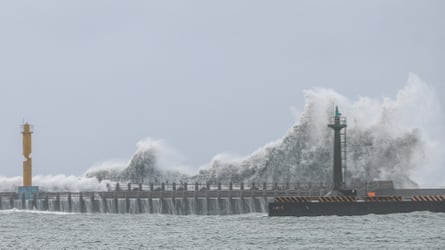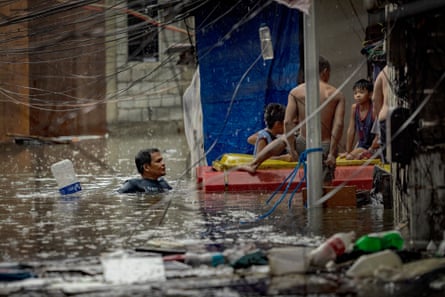The Philippines coastguard said it was “racing against time” to contain a massive oil spill that was at risk of becoming the biggest in the country’s history.
The MT Terra Nova, a Philippine-flagged tanker carrying 1.4m litres of oil, capsized in Manila Bay in the early hours of Thursday, as Typhoon Gaemi charged through the busy shipping route, whipping up aggressive winds and leaving 25 people dead in Taiwan and the Philippines.
By Thursday evening the Philippine coastguard said that an oil slick 4km long had been detected, with efforts under way to contain the damage. There are fears that the oil slick could reach the coastline of the Philippines’ bustling capital, Manila. The rough waters and high waves caused by Typhoon Gaemi have hampered cleanup efforts.
The authorities have not directly linked the capsizing to the typhoon, which passed through the area on Wednesday and brought torrential rain and high seas, but were investigating “if there was an existing weather disturbance in the vicinity waters”.
The typhoon crashed into China coast later on Thursday, prompting warnings of flash floods. More than 240,000 people in Fujian, a province on China’s east coast, were evacuated ahead of the typhoon’s arrival. All passenger trains in Fujian were suspended for Thursday and part of Friday, state media reported. Offshore construction projects were evacuated and ships returned to shore.
Poor weather on Taiwan’s south-east coast was hampering search and rescue operations after nine Myanmar crew fell overboard from a Tanzania-flagged cargo ship named Fu Shun that was hit by rough seas, Taiwan officials told the Guardian. A distress call was sent at approximately 6.30am on Thursday which said the boat was sinking. Three other vessels ran aground during the storm. Crews were safe or waiting to be rescued, Taiwan authorities said.
Gaemi hit Taiwan’s eastern Yilan County as a super typhoon after circling off the coast at about midnight local time on Thursday, said Taiwan’s weather bureau.
It had caused downpours and strong gusts across Taiwan before its arrival, killing one scooter rider in the southern city of Kaohsiung who was crushed by a falling tree, a woman in eastern Hualien who died after a wall fell on the car she was in and a neighbourhood leader in New Taipei who was driving an excavator that overturned, the authorities said.

More than 270 people were injured by Wednesday evening while more than 290,000 homes were plunged into darkness due to power outages, disaster officials said. Almost 170 incidents of flooding had also been reported, with waters yet to recede in most cases. “Wind and rain continue to intensify, posing a threat to various parts of Taiwan, [and its outlying islands of] Penghu, Kinmen, and Matsu … [the public should] be on high alert.”
The first typhoon to make landfall in Taiwan this year, Gaemi was expected to be the strongest in eight years, a government forecaster said.
By 8pm on Wednesday, authorities had evacuated more than 8,500 people living in precarious conditions across Taiwan, particularly in Hualien – a mountainous area with a high risk of landslides.
Trains and ferry services were suspended and hundreds of international and domestic flights were cancelled. Work and schools were closed across most of the island on Wednesday, prompting large crowds at supermarkets. In what is something of a social tradition when the government declares typhoon days, people booked out karaoke rooms.
The weather also forced the self-ruled island to cancel some of its annual Han Kuang war games – which test preparedness for a Chinese invasion – though an anti-landing drill went ahead as scheduled on Wednesday morning on Penghu, west of Taiwan’s main island.

Schools and offices were to remain closed for the second day in a row in several cities – including Taipei – with the authorities expecting adverse weather to continue across the island.
Government offices were closed and streets emptied in the capital, Taipei, while some stores had their entrances sandbagged to keep out flood water.
The Taiwanese company TSMC, the world’s largest silicon chipmaker, said it would maintain normal production and that it had “activated routine typhoon alert preparation procedures” at all fabrication plants.
Earlier, landslides killed six in provinces surrounding Manila, police and disaster officials in the Philippines said.

In Japan, weather authorities in the southern island region of Okinawa urged residents to “exercise strong vigilance” against storms, high waves and floods.
Taiwan is accustomed to frequent tropical storms from July to October but experts say climate change has increased their intensity, leading to heavy rains, flash floods and strong gusts, and increasing the chance of landslides.
Human-caused climate breakdown has increased the occurrence of the most intense and destructive tropical cyclones (though the overall number each year has not changed globally). This is because warming oceans provide more energy, producing stronger storms.
Extreme rainfall from tropical cyclones has increased substantially, as warmer air holds more water vapour. For example, the amount of rainfall produced by Hurricane Harvey in Texas in 2017 would have been all but impossible without the record warm ocean water in the Gulf of Mexico.
Coastal storm surges are also higher and more damaging due to the sea level rise driven by climate breakdown. For example, the devastating storm surge from Typhoon Haiyan, which hit the Philippines in 2013, was about 20% higher due to human-caused climate breakdown.
With Agence France-Presse
Source: theguardian.com


